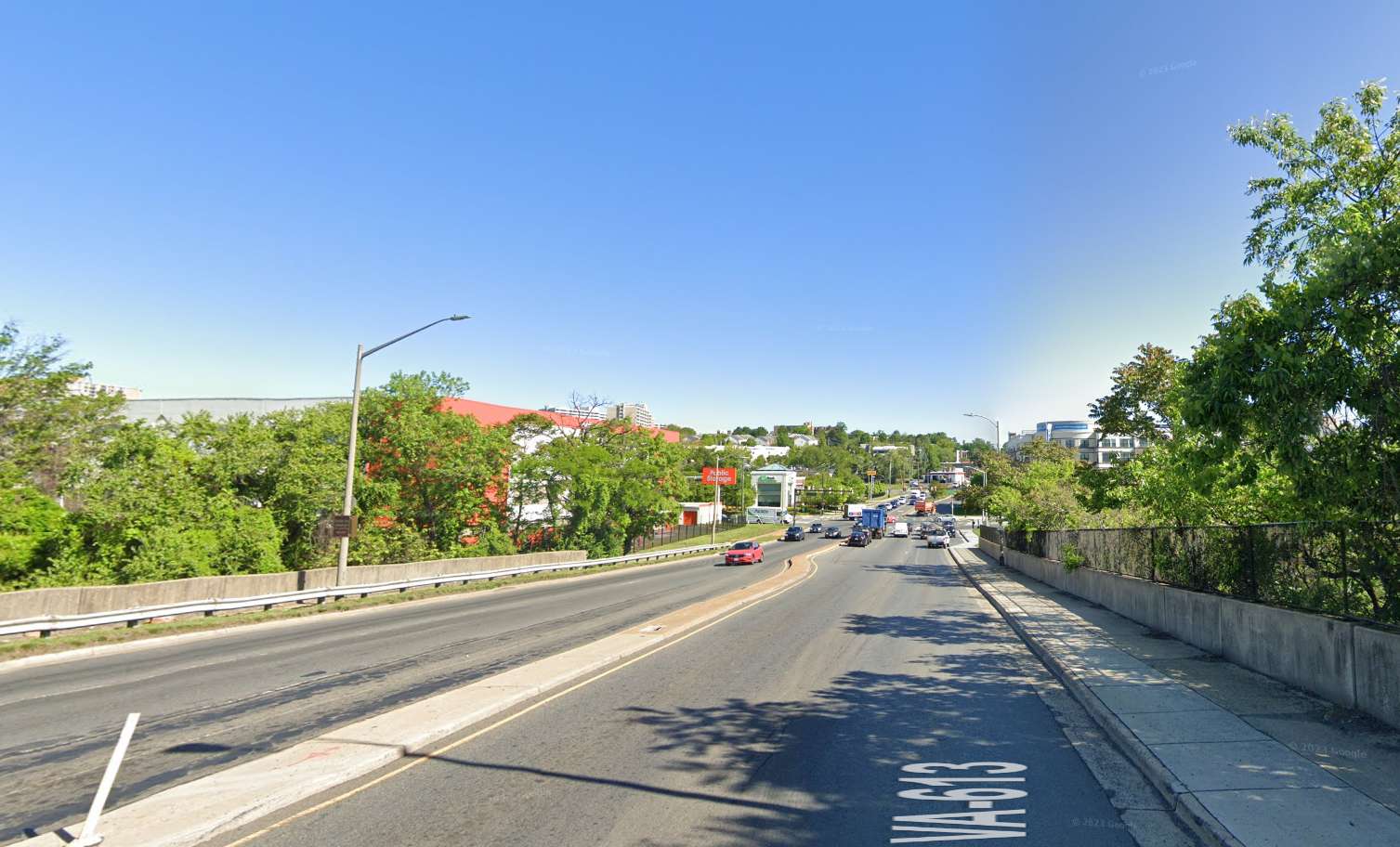
If Alexandria wants the transit corridors it dreams of, Planning Commission Chair Nathan Macek said it’s going to need to do more to secure federal funding.
In a budget discussion at the Planning Commission meeting last week, Macek noted that there is “no plan to pursue federal money” for two of the major transit corridors in the city budget.
Transitway corridors are areas where the city is hoping to implement “enhanced transit services” like bus rapid transit, a streetcar, dedicated bus lanes and more. Corridor B is the Duke Street / Eisenhower Avenue corridor. Corridor C is the Van Dorn Street / Beauregard Street corridor.
Macek said in the meeting that the funding set aside for transit development on those corridors is all local and regional funding.
“I will make, at every call, every opportunity I have, the call that we should be pursuing federal money for these projects,” Macek said.
Macek said he has concerns that the city is missing out on a chance to make those transit on those corridors better.
“My concern with the way we’re deploying BRT is we’re so content to make it happen with local and regional, and we’re not pursuing federal money that could help make this a real, functional, better bus rapid transit,” Macek said. “Totally missing that opportunity to pursue federal funds that could help us address the issues we have in these corridors.”
Staff told Macek at the meeting that one of the limits of the budget is it doesn’t show what avenues are being pursued, just what’s secure in the budget. Staff said efforts are underway to lock down federal funding for transit corridors.
Macek noted the Van Dorn Street Corridor in particular, which is seeing an upswing in new projects like the Vulcan property development, could benefit from federal funding for transit needs and possible widening.
“When we’re only working with local and regional money, we necessarily limit the scope of what we can accomplish because of that,” Macek said.
Photo via Google Maps
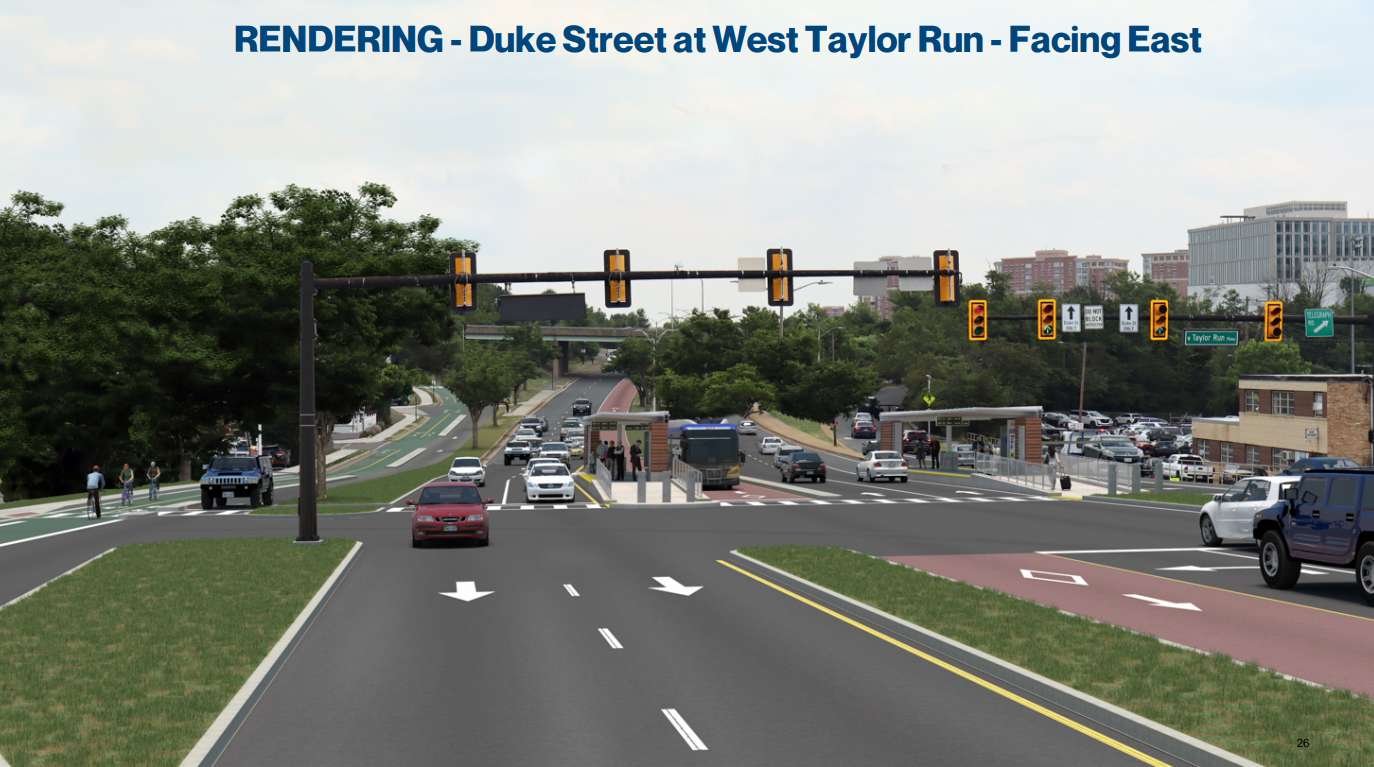
Alexandria’s bus rapid transit (BRT) ambitions for Duke Street are getting a federal boost.
The Federal Transit Administration announced that Alexandria will receive $550,000 in grant funding for transit-oriented development planning on the Duke Street corridor.
Last year, the City of Alexandria voted to move forward with dedicated bus lanes on portions of Duke Street, part of an effort to make the material roadway more transit-friendly.
According to the grant:
The city of Alexandria will receive funding to plan for TOD along the proposed Duke Street Bus Rapid Transit corridor. The planned BRT corridor will provide transit access along an approximate 3.7-mile stretch of Duke Street, connect two ends of the City from the planned West End (former Landmark Mall) mixed-use development to the King Street Metrorail Station and Alexandria Union Station, which will connect Duke Street to regional transit and commuter rail.
The project is estimated to cost a total $87 million. Construction is scheduled to start sometime in 2026.
Alexandria's been awarded $550k to plan for transit-oriented development along Duke Street, following the approval of Duke Street in Motion's BRT line
A great example of how transit and housing go hand-in-handhttps://t.co/6XncfuC0Ms
— Alex Goyette (@Alex_Goyette) April 2, 2024
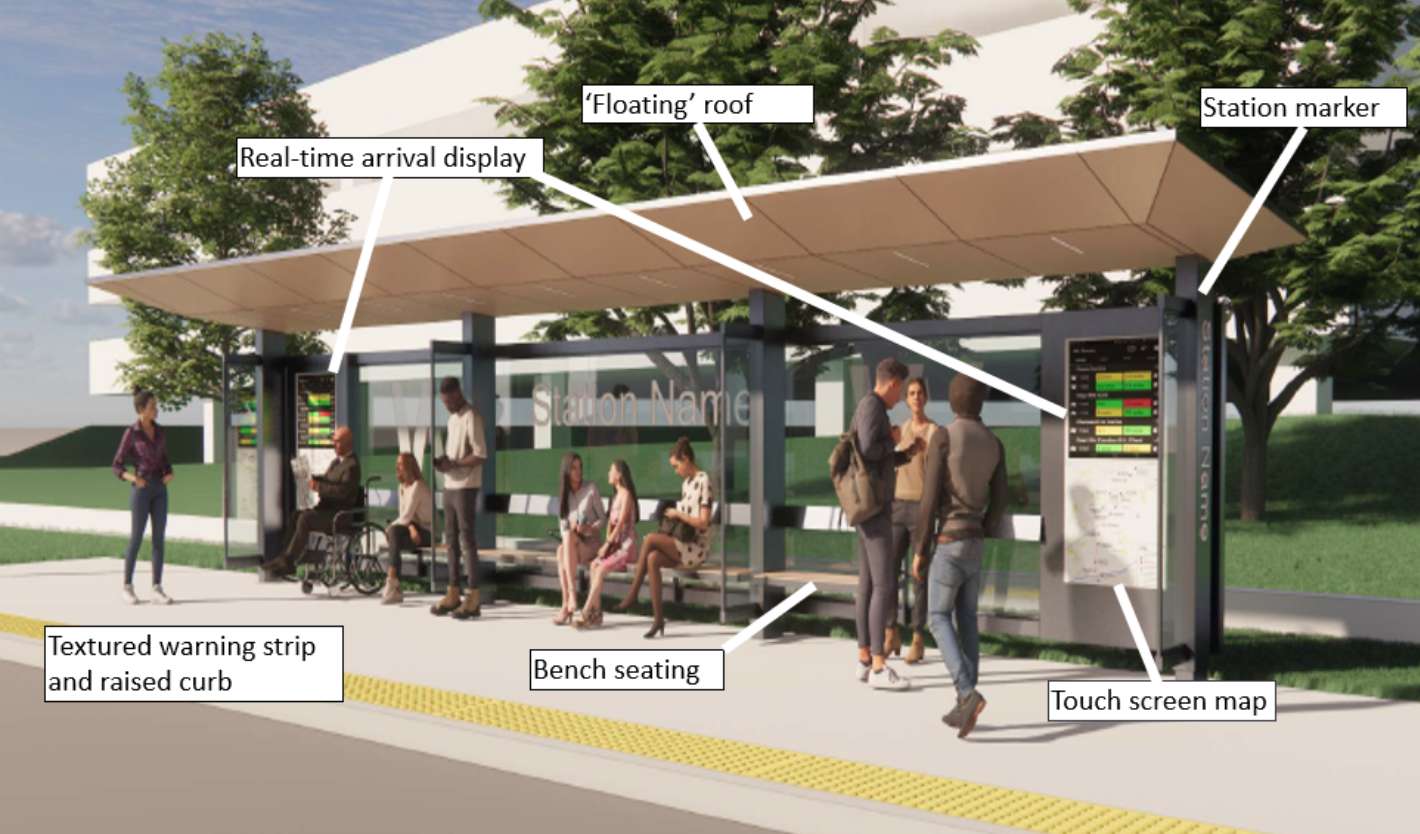
What makes a good bus stop?
Though Alexandrians probably shouldn’t expect Arlington’s $1 million bus stop, the city is looking for feedback on what kind of amenities should be included on the new West End Transitway.
The West End Transitway is a proposed bus rapid transit system that will run from the Van Dorn Metro station, past the new Landmark development and Mark Center, up to Shirlington.
According to the city website:
The West End Transitway will connect major transit facilities – Van Dorn Metrorail Station, a new transit hub at the former Landmark Mall site, Mark Center Transit Center, a new Southern Towers transit hub, Shirlington Transit Center, and the Pentagon Transit Center – and several neighborhoods along the corridor – Van Dorn/Landmark, a redeveloped Landmark Mall, and Beauregard. This is one of three BRT corridors planned for the City, including the existing Metroway line.
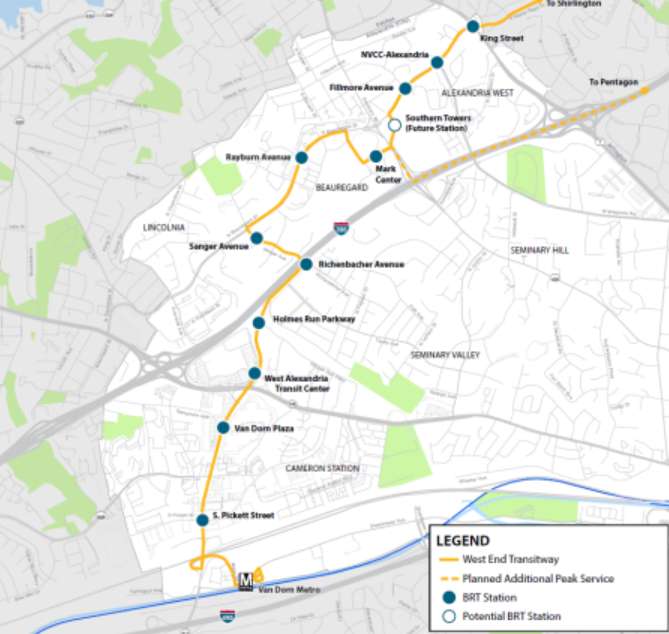
A survey by the city shared a concept for a bus station on the new West End Transitway and asked residents what they do or don’t like about their current bus stops.
The survey also asks bus riders to rank their priorities for new station amenities, including:
- Smart lighting that gets brighter when a person is at the station
- Trees to shade the area
- Solar power to reduce energy use
- Free WiFi
- Interactive screens
- Charging stations for e-bikes or scooters nearby
- Highly visible station names
- Charging ports for phones or other devices
The city’s website said design for the West End Transitway will run through mid-2024, with construction lasting from early 2025 to mid-2027. The first phase of the West End Transitway should begin operating in 2027.

Arlington calls for aid, and Alexandria will answer.
Alexandria’s City Council is scheduled to vote at a meeting on Tuesday, Sept. 26, to support neighboring Arlington’s funding application for an expanded Shirlington Transit Center.
Arlington County is applying for funding from the Northern Virginia Transportation Authority to expand the transit center in Shirlington, a major hub for bus traffic.
“Arlington County has requested $11.6 million to fund the Shirlington Bus Station Expansion,” Director of Transportation and Environmental Services Adriana Castaneda wrote in a memo. “This station is the principal transfer point for Arlington Transit (ART) bus service, Washington Area Metropolitan Transit Authority (WMATA) Metrobus service, and bus service (Routes 36A and 36B) in South Arlington.”
While the project is outside of Alexandria, Castaneda said Alexandria would benefit from the project as some of those added bus bays would serve the West End Transitway, which will stop at the Shirlington Bus Station.
“This capital project focuses on adding bus bays at the Shirlington Bus Station to meet future demand, including the space needed for future West End Transitway buses and any service improvements from Alexandria’s Transit Vision Plan, as well as expansion plans of Arlington Transit and WMATA,” Castaneda wrote.
The West End Transitway is a project that will connect transit facilities along the West End, from the Van Dorn Metro station up to Shirlington, passing through the redeveloped Landmark Mall site. The project is in the design phase, with construction scheduled for 2025-2026, opening sometime in late 2026.
Image via Google Maps
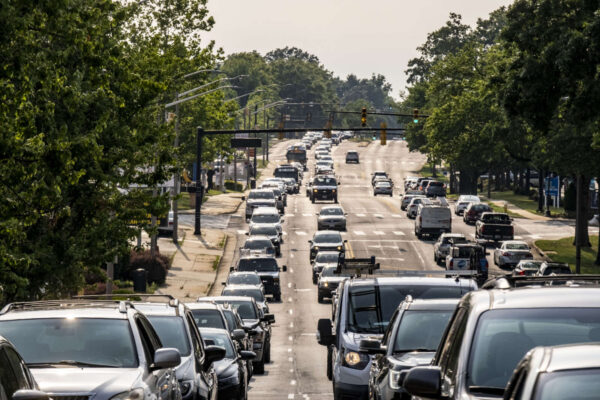
After years of discussion, the Duke Street Transitway is headed to Alexandria’s City Council this week.
The plan is going to a public hearing at the City Council meeting tomorrow (Tuesday).
The recommended plan, called Concept A, involves a mix of center-running and mixed-traffic along Duke Street. From Van Dorn Street to just past Jordan Street, the transitway would have buses in a pair of dedicated, center-running lanes, but it gets more complicated east of Jordan Street.
For around half of the length of the Duke Street Transitway, the buses will be in mixed traffic on both sides of the street or only have dedicated center-running lanes on one direction. The middle section of the transitway, Segment 2, proved the most restrictive to some of the more ambitious designs of the transitway.
The plan noted the long-term goal would be eventually having center-running bus lanes all along Duke Street, though these plans are dependent on both redevelopment along the corridor and available funding.
Beyond buses, the plans also include recommendations for shared-use paths along Duke Street, making the road more usable for cyclists and pedestrians. The recommendation is to have, at a minimum, uninterrupted sidewalks on both sides of Duke Street. The north side of the corridor, the plan said, should have a separate two-way cycle track for the sections at either end of the corridor.

Tomorrow evening City Council will be accepting public testimony and acting on the recommendations of our resident task force as we work to expand and improve transit on Duke Street:https://t.co/T9PajPEOoz
— Justin Wilson (@justindotnet) June 26, 2023
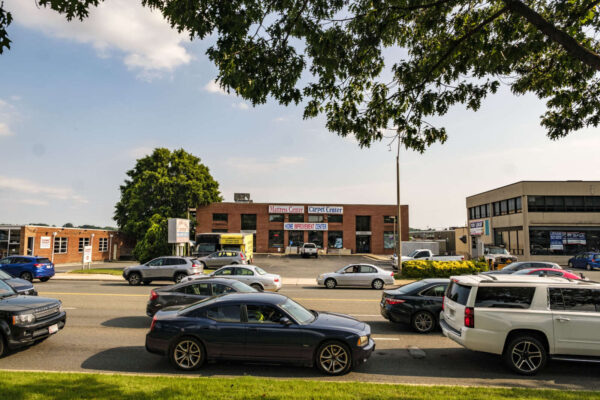
Back-and-forth arguments over the Duke Street Transitway had shades of Seminary Road at discussions during a Transportation Commission meeting last week.
The proposed transitway is part of the Duke Street In Motion project which aims to revamp Duke Street to prioritize public transit and walkability alongside car traffic. The transitway will potentially mix dedicated bus lanes and mixed-traffic lanes for a new system that should make transit more efficient along Duke Street.
At the meeting, criticism came from voices ranging from civic association leadership to a former DASH general manager.
“I love DASH, anything the city can do to encourage ridership… can serve to make the city a better place to live,” said Sandy Modell, an Alexandria Living Legend and former DASH General Manager. “[But] we’re not studying what’s happened since covid and before covid when Metrorail, DASH and Metro bus were all experiencing ridership loss.”
Modell said the city is dedicating a lot of money to a project without a full understanding of how transit ridership will evolve.
Although the city received an $87 million grant from the Northern Virginia Transportation Authority for planning, design, and construction of a transitway along the Duke Street Corridor from Landmark Mall to King Street Metro Station, some in the audience raised concerns this may not accurately represent the full cost of the project.
“We have an upwards of $100 million project if not more being considered tonight that will significantly impact travel on the corridor both during and after construction, but what we don’t have is a full evaluation and study of the changes that have taken place on that system since we’ve gone fare-free and since we put in a new DASH network,” Modell said.
Carter Flemming, Chair of the Alexandria Federation of Civic Associations, likewise said the project seems rooted in outdated assumptions about work and travel patterns.
Bill Rossello, President of the Seminary Hill Association, said there are unanswered questions about the cost of the project and the design.
“So it seems that the city is preparing to commit a huge amount of grant money and inevitably a lot of direct city taxpayer money to a confusing project that most residents don’t want, didn’t ask for, and don’t understand, and one that doesn’t promise to relieve traffic congestion and may not improve travel times for anyone,” Rossello said.
The project also had some support. Ken Notis, Chair of the Alexandria Bicycle and Pedestrian Advisory Committee, said there is more cost to further study than gain.
“There have been calls for delay and delay and study and more study,” Notis said. “I have done benefit-cost analysis professionally, I have done transportation analysis professionally: that further analysis isn’t free, it costs money, there will always be something else that someone wants studied. You can’t delay doing something forever because things change. The need for more transit has only grown.”

Alexandria’s Duke Street transitway could have dedicated bus lanes, but it’s unlikely they’ll run the full length of the corridor.
At a presentation to the City Council on Monday, city staff offered a look at how plans for the Duke Street transitway plans are coming together.
The idea of the transitway is to redesign the streetscape to better facilitate public transit. The project looks at Duke Street between the Landmark area and the King Street Metro.
Hillary Orr, deputy director of Transportation & Environmental Services, and project manager Jen Monaco said an advisory group suggested dedicated bus lanes at either end of the project area, but possibly keeping buses mixed into the regular flow of traffic towards the center of that corridor — between Jordan Street and Roth Street.
“At either end, [we’re looking at] at design options that do the most for transit: center and curb running,” said Monaco. “In the middle of the corridor, where taking more space means greater impacts on property, they chose to look at mixed traffic and a bidirectional option. We’re combining these options for each segment into two end-to-end corridor alternatives to allow for a more complete analysis.”
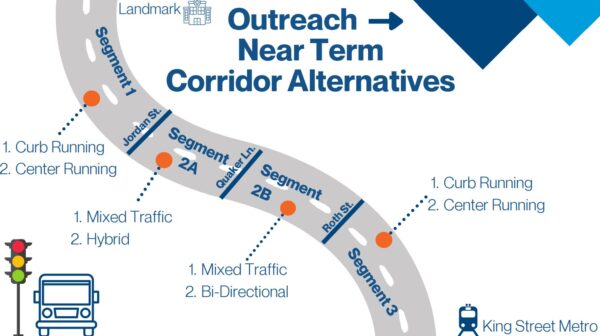
Where the city could install dedicated bus lanes, that could take a travel lane away from cars.
“Right now there are three travel lanes plus alternatives and even more at some intersections,” Orr said. “We are looking at taking one of those lanes in each direction and converting them into bus lanes.”
Monaco said the goal is to bring a recommendation to the City Council this summer.
The transitway is part of a broader suite of improvements for Duke Street. Orr noted that Duke Street is the highest crash corridor in the city.
“There are a lot of real issues with this corridor,” Orr said. “It’s a central connection for our community to reach homes, businesses, jobs, parks and libraries, but there is a lot of traffic congestion that leads to cut-through traffic in neighborhoods.”
Mayor Justin Wilson said one of his hopes for the project is to fix some of the crash-prone and all-around terrible intersections where Duke Street crosses Jordan Street and Quaker Lane.
“At both of those intersections could end up with solutions that become the focal points of the project… Jordan especially because of the service roads and the complexity of that,” said Wilson. “It’s a mess for pedestrians and a mess for drivers. It’s a horrible intersection for drivers. Anything we can do to improve the flow through there is a real opportunity for us. While this is a transit project, it’s a project that could have some significant ancillary benefits to pedestrians and drivers throughout this corridor.”

